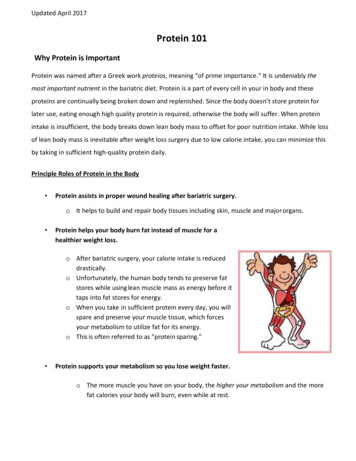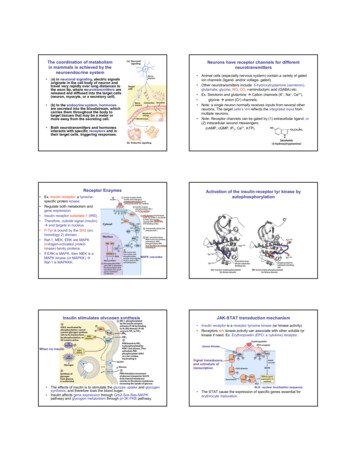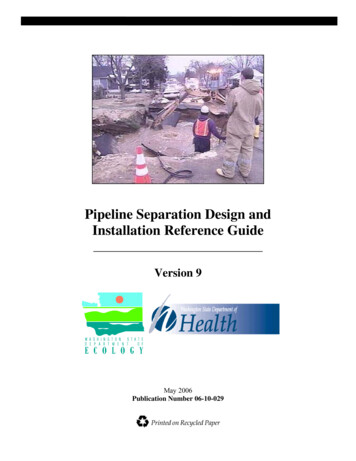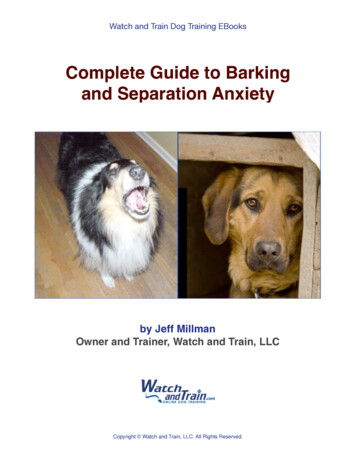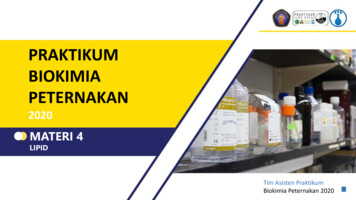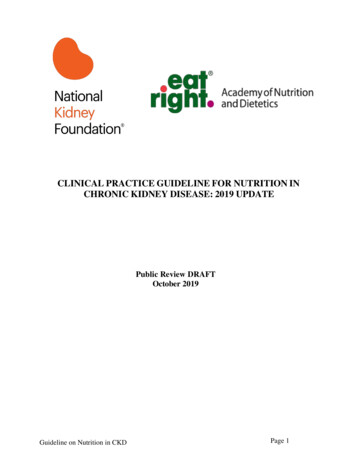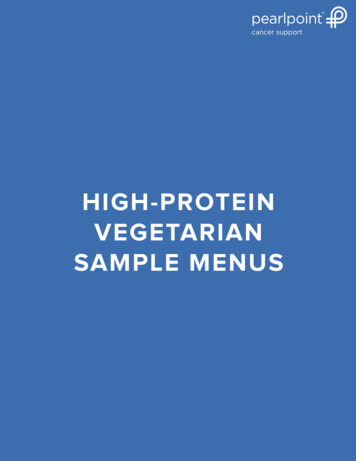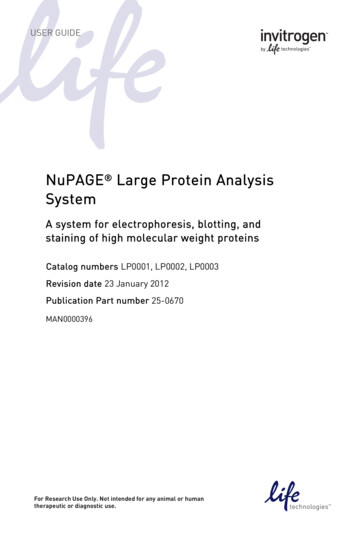
Transcription
USER GUIDENuPAGE Large Protein AnalysisSystemA system for electrophoresis, blotting, andstaining of high molecular weight proteinsCatalog numbers LP0001, LP0002, LP0003Revision date 23 January 2012Publication Part number 25-0670MAN0000396For Research Use Only. Not intended for any animal or humantherapeutic or diagnostic use.
ii
ContentsKit Contents and Storage . ivIntroduction . 1Overview. 1Methods . 6Perform SDS-PAGE . 6Western Blot . 10Use SimplyBlue SafeStain. 15Use the SilverQuest Silver Staining Kit . 19Appendix . 25Accessory Products. 25Technical Support . 26Purchaser Notification . 27iii
Kit Contents and StorageThis manual is shipped with the following products:Types ofProductsProductQuantity NuPAGE LargeProteinBlotting KitCat. no.NuPAGE Large ProteinBlotting Kit1 kitLP0001NuPAGE Large ProteinStaining Kit1 kitLP0002NuPAGE Large ProteinSensitive Staining Kit1 kitLP0003The NuPAGE Large Protein Blotting Kit contents are listedin the following table. Sufficient reagents are included torun and blot 20 mini-gels.Store the kit contents as listed in the following table.ComponentQuantityStorageHiMark Pre-Stained HighMolecular (HMW) Weight ProteinStandard250 μL 30 C to 10 CNuPAGE Novex 3–8% Tris-AcetateGel (1.0-mm, 10 wells)20 gels2 C to 8 CNuPAGE Tris-Acetate SDS BufferKit1 kit (page vi)2 C to 8 CNuPAGE Transfer Buffer (20X)1LRoom temperature,15 C to 30 CNitrocellulose Membrane/FilterSandwiches (0.45 μm)20 sandwichesRoom temperature,15 C to 30 CProduct UseFor research use only. Not intended for any animal orhuman therapeutic or diagnostic use.Continued on next pageiv
Kit Contents and Storage, ContinuedNuPAGE LargeProteinStaining KitThe NuPAGE Large Protein Staining Kit contents are listedin the following table. Sufficient reagents are included torun and stain 20 mini-gels.Store the kit contents as listed in the following table.ComponentQuantityStorageHiMark Pre-Stained HMW ProteinStandard250 μL 30 C to 10 CNuPAGE 3–8% Tris-Acetate Gel(1.0-mm, 10 wells)20 gels2 C to 8 C1 kit (next page)2 C to 8 C1LRoom temperature,15 C to 30 CNuPAGE Tris-Acetate SDS BufferKitSimplyBlue SafeStain**Sufficient SimplyBlue SafeStain is included to stain 50 mini-gels.NuPAGE LargeProteinSensitiveStaining KitThe NuPAGE Large Protein Sensitive Staining Kit contentsare listed in the following table. Sufficient reagents areincluded to run and stain 20 mini-gels.Store the kit contents as listed in the following table.ComponentQuantityStorageHiMark Unstained HMW ProteinStandard250 μL 30 C to 10 CNuPAGE 3–8% Tris-Acetate Gel(1.0-mm 10 wells)20 gels2 C to 8 CNuPAGE Tris-Acetate SDS Buffer Kit1 kit (page vi)2 C to 8 CSilverQuest Silver Staining Kit1 kit (page vi)Room temperature,15 C to 30 CContinued on next pagev
Kit Contents and Storage, ContinuedNuPAGE Tris-AcetateSDS BufferKitThe NuPAGE Tris-Acetate SDS Buffer Kit contents arelisted in the following table.Store the kit at 2 C to 8 C.ComponentAmount NuPAGE Tris-Acetate SDS RunningBuffer (20X)500 mLNuPAGE LDS Sample Buffer (4X)10 mL 15 mL 250 μLNuPAGE AntioxidantNuPAGE Sample Reducing Agent (10X)SilverQuest The SilverQuest Silver Staining Kit contents are listed inthe following table. Sufficient reagents are included to stainSilverStaining Kit 25 mini-gels.Store the kit at room temperature, 15 C to 30 C.ItemAmountColorSensitizer250 mLOrangeStainer25 mLClearDeveloper250 mLPink2 mLClearStopper250 mLClearDestainer A60 mLYellowDestainer B60 mLClearDeveloper Enhancervi
IntroductionOverviewDescriptionThe NuPAGE Large Protein Analysis System consists of3 kits specifically designed for separating and analyzinghigh molecular weight (HMW) proteins in the molecularweight range of 30-500 kDa.The kits include pre-cast NuPAGE Novex Tris-Acetate Gelsand buffers for high-resolution electrophoresis of HMWproteins in the neutral pH range (page 3). The pre-cast gelsare designed for use with the XCell SureLock he HMW proteins are involved in a large variety ofimportant pathways such as cell signaling, nuclear proteintransport, DNA repair, and in disease states such as cancer.SystemOverviewHigh molecular weight protein samples are prepared usingthe NuPAGE Sample Buffer and electrophoresed onNuPAGE Novex Tris-Acetate Gels with the NuPAGE Tris-Acetate SDS Running Buffer using the XCell SureLock Mini-Cell.The NuPAGE Large Protein Analysis System allows you torapidly and efficiently separate high molecular weightproteins on polyacrylamide gels and provides sensitivestains for detection. The kits also include a protein standardspecifically designed for analyzing high molecular weightproteins and allow you to easily determine proteinmolecular weight in the range of 30–500 kDa.Based on the kit that you have purchased, you can stain orblot the proteins after electrophoresis. The proteins can bestained using a Coomassie based SimplyBlue SafeStain(NuPAGE Large Protein Staining Kit) or a sensitiveSilverQuest Silver stain, (NuPAGE Large ProteinSensitive Silver Staining Kit). The proteins can also besubjected to western transfer onto the nitrocellulosemembrane with the NuPAGE Transfer Buffer (NuPAGE Large Protein Blotting Kit) using the XCell II Blot Module.Continued on next page1
Overview, ContinuedNuPAGE LargeProteinBlotting KitThe NuPAGE Large Protein Blotting Kit is ideal for Westernblotting of high molecular weight proteins. The kit includespre-cast gels, pre-made buffers, and pre-assemblednitrocellulose membrane/filter paper sandwiches to ensureconsistent results and eliminates the need to prepare reagents.A pre-stained protein standard (HiMark ) specificallydesigned for analyzing high molecular weight proteins is alsoincluded to allow you to easily monitor the protein transfer.This kit is designed for use with the XCell II Blot Module.NuPAGE LargeProteinStaining KitThe NuPAGE Large Protein Staining Kit provides a fast andsensitive method of protein detection using the SimplyBlue SafeStain. The kit includes pre-cast gels, pre-made buffers,SimplyBlue SafeStain, and a pre-stained HMW proteinstandard (HiMark ). The stain can detect protein bands atnanogram level, is safe, non-hazardous, and easy to dispose.Proteins stained using SimplyBlue SafeStain are compatiblewith mass spectrometry analysis.NuPAGE LargeProteinSensitiveStaining KitThe NuPAGE Large Protein Sensitive Staining Kit provides arapid and easy method to silver stain proteins and allows youto detect protein bands at nanogram level. The kit includespre-cast gels, pre-made buffers, SilverQuest Silver StainingKit, and an unstained HMW protein standard (HiMark ). TheSilverQuest Silver Staining Kit is specifically designed toprovide sensitive silver staining compatible with massspectrometry analysis.Purpose ofthe ManualThis manual provides the following information: An overview of the NuPAGE Large Protein AnalysisSystem Instructions for electrophoresis of proteins Protocols for staining using the SimplyBlue Safestainand SilverQuest Silver Staining Kit Western blotting protocol using the XCell II Blot ModuleFor more details, refer to the NuPAGE Technical Guideavailable from www.lifetechnologies.com or contactTechnical Support (page 26).Continued on next page2
NuPAGE Electrophoresis SystemIntroductionThe NuPAGE Large Protein Analysis System Kits aresupplied with high-performance NuPAGE Novex 3–8%Tris-Acetate Gels and NuPAGE Tris-Acetate SDS Buffer Kitfor optimal resolution of high molecular weight proteins.NuPAGE Tris-AcetateGelsThe NuPAGE Novex 3–8% Tris-Acetate Pre-Cast Gel is a1.0 mm thick, 10 10 cm mini-gel used for electrophoresisof high molecular weight proteins. The gels resolve proteinsin the molecular weight range of 30–500 kDa.The NuPAGE Novex Tris-Acetate Pre-Cast Gels are usedwith the NuPAGE Tris-Acetate SDS Buffer System (see thefollowing section) to produce a discontinuous SDS-PAGEsystem operating at neutral pH. The neutral pHenvironment during electrophoresis results in maximumstability of both proteins and gel matrix, providing betterband resolution than other gel systems.For more details, refer to the NuPAGE Technical Guideavailable at www.lifetechnologies.com, or contactTechnical Support (page 26).NuPAGE Tris-AcetateBufferSystemThe NuPAGE Tris-Acetate discontinuous buffer systeminvolves three ions: Acetate (-) is supplied by the gel buffer and serves as aleading ion due to its high affinity to the anode ascompared to other anions in the system. The gel bufferions are Tris ( ) and Acetate (-), pH 7.0. Tricine (-) serves as the trailing ion from the runningbuffer. The running buffer ions are Tris , Tricine-, anddodecylsulfate (-), pH 8.3. Tris ( ) is the common ion present in the gel buffer andrunning buffer. The Tris-Acetate system also operates ata significantly lower operating pH of 8.1 duringelectrophoresis.Continued on next page3
NuPAGE Electrophoresis System,ContinuedAdvantagesNuPAGE LDS SampleBufferNuPAGE ReducingAgentThe operating neutral pH of NuPAGE Gels and buffersprovide the following advantages over the Laemmli system: Longer shelf life of 8 months due to improved gelstability Improved protein stability during electrophoresis atneutral pH resulting in sharper band resolution andaccurate results Complete reduction of disulfides under mild heatingconditions (70 C for 10 minutes) and absence ofcleavage of asp-pro bonds using the NuPAGE LDSSample buffer (pH 7.0 at 70 C) Reduced state of the proteins maintained duringelectrophoresis and blotting of the proteins by theNuPAGE AntioxidantUse the NuPAGE LDS Sample Buffer (4X) to preparesamples for denaturing gel electrophoresis with theNuPAGE Tris-Acetate Gels.Since the pH of the NuPAGE LDS Sample Buffer is 8.4,sample reduction at slightly alkaline pH allows for maximalactivity of the reducing agent.The NuPAGE Reducing Agent contains 500 mMdithiothreitol (DTT) at a 10X concentration and is availablein a ready-to-use, stabilized liquid form (page 25). Use theNuPAGE Reducing Agent to prepare samples for reducinggel electrophoresis.We recommend adding the reducing agent to the samplewithin an hour of loading the gel.Avoid storing reduced samples for long periods even if theyare frozen. This will result in the reoxidation of samplesduring storage and produce inconsistent results.Continued on next page4
NuPAGE Electrophoresis System,ContinuedNuPAGE AntioxidantThe reducing agents, DTT and β-mercaptoethanol, do notco-migrate through the gel with the sample in a neutral pHenvironment of the NuPAGE Gels. Instead, the reducingagent tends to remain at the top of the gel and not migratefully throughout the gel resulting in the reoxidization ofsome proteins producing slightly diffuse bands.The NuPAGE Antioxidant (a proprietary reagent) is addedto the running buffer in the upper (cathode) buffer chamberonly when performing electrophoresis under reducingconditions. The NuPAGE Antioxidant migrates with theproteins during electrophoresis preventing the proteinsfrom reoxidizing and maintaining the proteins in a reducedstate. The NuPAGE Antioxidant also protects sensitiveamino acids such as methionine and tryptophan fromoxidizing.ImportantDo not use the NuPAGE Antioxidant as a sample reducingagent. The antioxidant is not efficient in reducing thedisulfide bonds. This will result in partially reduced bandswith substantial background smearing in the lane.The antioxidant maintains the sample proteins that havebeen previously reduced with a reducing agent in a reducedstate and prevents the proteins from reoxidizing duringelectrophoresis.5
MethodsPerform SDS-PAGEIntroductionInstructions to perform SDS-PAGE under denaturingconditions using the XCell SureLock Mini-Cell are describedin this section.HiMark ProteinStandardThe HiMark High Molecular Weight (HMW) ProteinStandard allows you to estimate the molecular weight ofhigh molecular weight proteins on NuPAGE Novex TrisAcetate Gels with Tris-Acetate SDS buffer system. Thestandard is supplied in a ready-to-use format and there isno need to heat or reduce the standard prior to use.Use the appropriate HiMark HMW Protein Standardbased on your application: HiMark Pre-Stained HMW Protein Standard isincluded with the Large Protein Blotting and StainingKits and allows you to easily visualize proteinmolecular weight ranges during electrophoresis andevaluate western transfer efficiency. HiMark Unstained HMW Protein Standard is suppliedwith Large Protein Sensitive Staining Kit and allowsyou to accurately estimate molecular weight. UseCoomassie or silver staining after electrophoresis orPonceau S, Coomassie, SYPRO Ruby Blot Stain, orother membrane stains after western transfer tovisualize the unstained standard.A molecular weight calculator is available fromwww.lifetechnologies.com to allow you to easily andaccurately calculate the molecular weight of yourproteins on NuPAGE Novex Tris-Acetate Gels and toextrapolate the molecular weight of proteins beyond thestandard curve.Continued on next page6
Perform SDS-PAGE, ContinuedGels are individually packaged in clear pouches with 10 mLof Packaging Buffer. The Packaging Buffer contains lowlevels of residual acrylamide monomer and 0.02% sodiumazide. Wear gloves at all time when handling gels.Warning: This product contains a chemical (acrylamide)known to the state of California to cause cancer. To obtain aSDS, see page 26.Sufficient reagents are included in the NuPAGE TrisAcetate Buffer Kit to run 20 mini-gels when 2 mini-gels areused per electrophoresis run and 10 μL sample/well isprepared. You may need additional reagents from the bufferkit if you are using 1 mini-gel per run or preparing 25 μLsample/well. Ordering information is on page 25.RequiredMaterialsMaterials supplied by the user Protein sample Deionized water XCell SureLock Mini-Cell (page 25)Components included in the kit (see the preceding note) NuPAGE 3–8% Tris-Acetate Gel (1.0-mm, 10 wells) NuPAGE Tris-Acetate SDS Buffer Kit Appropriate HiMark HMW Protein StandardContinued on the next page7
Perform SDS-PAGE, ContinuedPrepare1X RunningBufferYou will need 1000 mL 1X NuPAGE Tris-Acetate SDSRunning Buffer for electrophoresis with the XCell SureLock Mini-Cell.1.Prepare 1000 mL 1X NuPAGE SDS Running Bufferusing NuPAGE SDS Running Buffer (20X):NuPAGE Tris-Acetate SDS Buffer (20X)Deionized Water950 mLTotal VolumePrepareSamples50 mL1000 mL2.Mix thoroughly and set aside 800 mL of the1X NuPAGE SDS Running Buffer for use in the Lower(Outer) Buffer Chamber of the XCell SureLock MiniCell.3.Immediately prior to electrophoresis, add 500 μL ofNuPAGE Antioxidant to 200 mL of 1X NuPAGE SDSRunning Buffer from step 1 of this procedure for use inthe Upper (Inner) Buffer Chamber of the XCellSureLock Mini-Cell. Mix thoroughly.The recommended protein load for a 10-well gel is0.5 μg/band for Coomassie staining and 1 ng/band forsilver staining. For western detection, load the amount ofprotein according to the sensitivity of your detectionmethod.Prepare your samples in a total volume of 10 μL:Note: If you need to prepare samples in a volume of5-25 μL, adjust the volume accordingly.1. To a sterile microcentrifuge tube, add the following:Protein SampleNuPAGE LDS Sample Buffer (4X)NuPAGE Reducing Agent (10X)Deionized Water2.x μL2.5 μL1 μLto 10 μLHeat samples at 70oC for 10 minutes. Immediately loadthe samples on the gel, page 9.Continued on next page8
Perform SDS-PAGE, ContinuedLoadSamples1.Assemble the XCell SureLock Mini-Cell as described inthe manual supplied with the unit. The manual isavailable from www.lifetechnologies.com or bycontacting Technical Support (page 26).2.Fill the Upper Buffer Chamber (inner) of the unit with200 mL 1X running buffer with antioxidant (see page 8for instructions to prepare running buffer). The bufferlevel must exceed the level of the wells.3.Load 10–25 μL sample at the intended proteinconcentration onto each well of the gel.4.Load HiMark Protein Standard as follows: For Coomassie staining and Western blotting,use 10 μL HiMark Pre-Stained HMW ProteinStandard For silver staining, use 5 μL of 1:10 dilutedHiMark Unstained HMW Protein Standard5.Fill the Lower (outer) Buffer Chamber with 600 mL 1Xrunning buffer (see page 8).6.Perform electrophoresis at constant voltage of 150 V for1 hour at room temperature.The expected start current is 40–55 mA/gel and theexpected end current is 25–40 mA/gel.7.After electrophoresis is complete, disassemble the XCellSureLock Mini-Cell and remove the gel from thecassette as described in the XCell SureLock Mini-Cellmanual.8.Proceed to blotting (page 10) or staining (page 15).9
Western BlotIntroductionThe NuPAGE Large Protein Blotting Kit includes reagentsto perform electrophoresis and blotting of high molecularweight proteins.Instructions for western blotting using the XCell II BlotModule and nitrocellulose membranes are described in thissection.For more details, refer to the XCell II Blot Module manualavailable from www.lifetechnologies.com, or contactTechnical Support (page 26).Nitrocellulose The Nitrocellulose membrane/filter paper sandwich(0.45 μm) included with the NuPAGE Large ProteinMembraneBlotting Kit contains 100% pure nitrocellulose to providehigh-quality transfer with high-sensitivity and lowbackground. The membrane is supplied in a pre-cut,pre-assembled membrane/filter paper sandwich for easyassembly and is compatible with detection methods such asstaining, immunodetection, fluorescence, or radiolabeling.The 0.45 μm Nitrocellulose Membrane has a bindingcapacity of 80 μg/cm2 of proteins and is ideal for thetransfer of most large proteins ( 20 kDa).NuPAGE TransferBufferThe NuPAGE Transfer Buffer (included with the kit) isrecommended for western transfer of proteins fromNuPAGE Tris-Acetate Gels. The transfer buffer maintainsthe neutral pH environment established during gelelectrophoresis, protects against modification of the aminoacid side chains and is compatible with N-terminal proteinsequencing using Edman degradation.The NuPAGE Large Protein Blotting Kit is supplied with0.45 μm nitrocellulose membranes. However, you can alsouse PVDF membranes (0.45 μm) for Western blotting usingthe protocol described in this section. PVDF membranes areavailable separately (page 25).Continued on next page10
Western Blot, ContinuedRequiredMaterialsMaterials supplied by the user Methanol XCell II Blot Module (page 25) Deionized water Optional: PVDF membranes (page 25)MENDIONATRECOMComponents included with the kit Nitrocellulose membrane/filter paper sandwich NuPAGE Transfer Buffer NuPAGE AntioxidantWear gloves at all times during the entire blottingprocedure to prevent contaminating gels and membranes,and to avoid exposing your skin to irritants commonly usedin electrophoresis and blotting procedures.Do not touch the membrane or gel with bare hands. Thismay contaminate the gel or membrane and interfere withfurther analysis.Prepare 1XTransferBufferPrepare 1000 mL of 1X NuPAGE Transfer Buffer with10% methanol* using the NuPAGE Transfer Buffer (20X)supplied with the kit:NuPAGE Transfer Buffer (20X)NuPAGE AntioxidantMethanolDeionized WaterTotal Volume50 mL1 mL100 mL849 mL1000 mL*Prepare NuPAGE Transfer Buffer with 20% methanol, ifyou are using HiMark Pre-stained Protein Standard withPVDF membranes or performing transfer of 2 gels in theblot module to obtain optimal transfer.Continued on next page11
Western Blot, ContinuedPrepareBlottingPads,Membrane,and FilterPaper Blotting Pads: Use 700 mL of transfer buffer to soak theblotting pads until saturated. Remove air bubbles bysqueezing the blotting pads while they are submerged inbuffer. Removing air bubbles is essential because they canblock the transfer of biomolecules. Nitrocellulose membrane: Place the nitrocellulosemembrane (supplied with the kit) directly in a traycontaining the transfer buffer for several minutes.Note: If you are using PVDF membranes for blotting,pre-wet the PVDF membrane for 30 seconds in methanol,ethanol, or isopropanol. Briefly rinse in deionized waterand then place the membrane in a tray containing transferbuffer for several minutes. Transfer1 GelFilter paper: Soak briefly in transfer buffer immediatelyprior to use.For transferring 1 gel using the XCell II Blot Module:1. After electrophoresis (page 9), remove gel from thecassette. Use the gel immediately without soaking the gelin transfer buffer.2. Place a piece of pre-soaked filter paper on top of your gel,and remove any trapped air bubbles. Turn the gel/filterpaper over so the gel is facing up.3. Place pre-soaked nitrocellulose membrane on the gel.Roll a glass pipette over the membrane surface to removeany air bubbles.4. Place the other pre-soaked filter paper on top of thetransfer membrane. Remove any trapped air bubbles.5. Place 2 soaked blotting pads onto the cathode (-) core ofthe blot module.Continued on next page12
Western Blot, ContinuedTransfer1 Gel,Continued6. Carefully pick up the gel/membrane assembly with yourgloved hand and place on the pad in the same sequence,such that the gel is closest to the cathode plate:Blotting Pad Blotting PadFilter PaperTransfer MembraneGelFilter PaperBlotting PadBlotting PadCathode Core (-)7. Add enough pre-soaked blotting pads to rise 0.5 cm over therim of the cathode core. Place the anode ( ) core on top ofthe pads.8. Hold the blot module together firmly and slide it into theguide rails on the lower buffer chamber.9. Insert the Gel Tension Wedge into the Lower BufferChamber and lock the Wedge into position.10. Fill the blot module with 1X NuPAGE Transfer Buffer untilthe gel/membrane assembly is covered.11. Fill the Outer Buffer Chamber with 650 mL deionized water.12. Attach the lid, connect the leads to the power supply, andperform Western transfer using conditions listed below.Note: To perform Western transfer of 2 gels, refer to the XCellII Blot Module manual. This manual is available by contactingTechnical Support (page 26) or tage:Time:Expected Current:30 V constant1 hour220 mA/gel (start of run)180 mA/gel (end of run)Overnight blotting Voltage:10–15 V constantRun Time:OvernightFor overnight blotting, perform transfer in the cold room toprevent overheating.Continued on next page13
Western Blot, ContinuedTransferEfficiencyYou can monitor the transfer of HiMark Pre-Stained HMWProtein Standard bands to determine the transfer efficiency. Ifmost of the standard bands have transferred to the membrane,then transfer efficiency is good.It is important to note that high molecular weight standardsdo not always transfer completely and is not indicative of anincomplete transfer.If none of the standard bands or only a few of standard bandshave transferred, or the transfer of your protein of interest isnot complete, you may have to optimize the transferconditions as described in the XCell II Blot Module manual.ExpectedResultsSee the following image for an example of a Western blot ofHiMark Pre-Stained HMW Protein Standard and an 500 kDa human protein run on a NuPAGE Novex 3–8% TrisAcetate Gel and transferred onto a nitrocellulose membraneusing the protocol described in this manual. The proteins weredetected using the WesternBreeze Chromogenic Kit with1:500 dilution of anti-human protein antibody. The blot wasdeveloped for 5 minutes with the chromogenic substrate.Efficient transfer of the standard bands and high molecularweight human protein is observed.1kDa4602682381711177155413114234Lane 1: 10 μL HiMark Pre-stainedStandardLane 2: 500 ng human proteinLane 3: 300 ng human proteinLane 4:100 ng human protein
Use SimplyBlue SafeStainIntroductionThe NuPAGE Large Protein Staining Kit includes thereagents to perform electrophoresis and staining withSimplyBlue SafeStain.Instructions for staining gels with SimplyBlue SafeStain areincluded in this section. For more details, refer to theSimplyBlue SafeStain manual available fromwww.lifetechnologies.com or contact Technical Support(page.26).SimplyBlue SimplyBlue SafeStain included with the NuPAGE LargeProtein Staining Kit is a ready-to-use, proprietary CoomassieSafeStainG-250 stain that is specially formulated for fast, sensitivedetection and safe, non-hazardous disposal. Proteins stainedusing the SimplyBlue SafeStain are compatible with massspectrometry (MS) analysis.RequiredMaterialsMaterials supplied by the user: Staining containers 20% NaCl (w/v) in deionized water Shaker Deionized water Optional: Microwave ovenComponents included with the kit: SimplyBlue SafeStainContinued on next page15
Use SimplyBlue SafeStain, ContinuedBasicProtocolAfter electrophoresis, follow the instructions below. Be surethe mini-gel moves freely in water or stain to facilitatediffusion during all steps.An alcohol/acetic acid fixing step prior to staining withSimplyBlue SafeStain is NOT required or recommended.1.Rinse the mini-gel 3 times for 5 minutes with 100 mLdeionized water to remove SDS and buffer salts, whichinterfere with binding of the dye to the protein. Discardeach rinse.2.Stain the mini-gel with enough SimplyBlue SafeStain( 20 mL) to cover the mini-gel. Stain for 1 hour at roomtemperature with gentle shaking. Bands will begin todevelop within minutes. After incubation, discard thestain. Do not re-use the stain.Note: The gel can be stained for up to 3 hours, but after3 hours, sensitivity will decrease. If you need to leavethe gel overnight in the stain, add 2 mL 20% NaCl(w/v) in water for every 20 mL of stain. This procedurewill not affect sensitivity.3.Wash the mini-gel with 100 mL water for 1-3 hours. Thegel can be left in the water for several days without lossof sensitivity. To obtain the highest sensitivity: After washingthe gel for 1 hour, add 20 mL 20% NaCl solution tothe water and continue to wash for 2 hours up toovernight. (Detection limit: 7 ng BSA.) To obtain the clearest background forphotography: Perform a second 1 hour wash with100 mL water.Note: Once in the second wash, sensitivity will decreaseif the gel is allowed to stay in the water more than1 day. If you need to store the gel in water for a fewdays, add 20 mL 20% NaCl to the solution.Continued on next page16
Use SimplyBlue SafeStain, ContinuedMicrowaveProtocolThe microwave protocol is fast, takes just 12 minutes, and canyield results with sensitivity as low as 5 ng with an additionalincubation with a salt solution.Note: Use caution while using the stain in a microwave oven.Do not overheat the staining solutions.1.After electrophoresis, place the gel in 100 mL deionizedwater in a loosely covered container and microwave onHigh (950 to 1100 watts) for 1 minute until the solutionalmost boils.2.Shake the gel on an orbital shaker for 1 minute. Discard thewater.3.Repeat Steps 1–2 two more times.4.After the last wash, add 20 mL SimplyBlue SafeStain andmicrowave on High for 45 seconds to 1 minute until thesolution almost boils.5.Shake the gel on an orbital shaker for 5 minutes.(Detection limit: 20 ng BSA.)6.Wash the gel in 100 mL of ultrapure water for 10 minuteson a shaker. (Detection limit: 10 ng BSA.)7.Add 20 mL of 20% NaCl for at least 5 minutes.(Detection limit: 5 ng BSA.) The gel can be stored forseveral weeks in the salt solution.DisposalInformationIn most cases, the SimplyBlue SafeStain can be diluted1:200 with water and flushed down the drain. Diluting thestain raises the pH to between 5 and 7, which complies withmost federal and state regulations. For disposal requirementsin your area, consult your safety officer.Dry theSimplyBlue SafeStainGelThe stained gel can be dried for storage or analysis by vacuumdrying or air-drying. We recommend using the DryEase MiniGel Drying System (page 25) to air-dry the gel.When using the DryEase Mini-Gel Drying System, be sure torestrict the incubation time of your SimplyBlue SafeStainstained gel in the Gel-Dry Drying Solution to 5 minutesbecause longer exposure can result in destaining of bands.Continued on next page17
Use SimplyBlue SafeStain, ContinuedExpectedResultsAn example of protein standards analyzed on a NuPAGE Novex 3–8% Tris-Acetate Gel and stained with SimplyBlue SafeStain Kit using the protocol described in this manual isshown below.The samples on the gel are:Lane 1:10 μL of HiMark Pre-Stained StandardLane 2:5 μL of HiMark Unstained StandardNote: The red, 171 kDa band from HiMark Pre-stainedStandard turns blue upon staining with SimplyBlue 5555414031182kDa
Use the SilverQuest Silver Staining KitIntroductionThe NuPAGE Large Protein Sensitive Staining Kit includes thereagents to perform electrophoresis and staining withSilverQuest Silver Staining Kit.Instructions for staining the gels with SilverQuest SilverStaining Kit are included in this section. For more details, referto the SilverQuest Silver Staining Kit manual available fromwww.lifetechnologies.com or contact Technical Support(page.26).SilverQuest The
The NuPAGE Antioxidant (a proprietary reagent) is added to the running buffer in the upper (cathode) buffer chamber only when performing electrophoresis under reducing conditions. The NuPAGE Antioxidant migrates with the proteins during electrophoresis preventing the proteins from reoxidizing and maintaining the proteins in a reduced state.


